Design and Thermal-Optical Environment Simulation of Double-Slope Greenhouse Roof Structure Based on Ecotect
Abstract
:1. Introduction
2. Materials and Methods
2.1. Greenhouse Parameter Setting
2.1.1. Test Greenhouse Parameters
2.1.2. Selection of Simulated Greenhouse Conditions
- Modeling of sky brightness distribution
- is the zenith luminance value.
- is the luminance value of any point in the sky.
- is the altitude angle of point M.
- is the angular distance degree between point M and the zenith.
- Shade room roof window spacing settings
- Shade room roof window width setting
2.1.3. Greenhouse-Equivalent Scale Model Parameters
2.2. Test Methods
2.2.1. Software Validation
2.2.2. Shade Room Light and Thermal Environment Simulation
- Simulation assessment of shade room light environment
- is the illuminance at the point indoors, received from the sky luminance distribution.
- is the illuminance on an unobstructed horizontal surface outdoors, generated by the sky’s diffuse light.
- is the illuminance produced by direct sunlight at the point.
- is the illuminance of the point subjected to scattered light from the sky.
- is the illuminance of the point that receives reflected light from outdoors.
- is the illuminance produced by reflected light from indoors.
- is the light intensity produced by direct sunlight on the horizontal outdoor surface.
- is the visible light transmittance of the glass.
- is the light-blocking discount factor of the window structure.
- is the pollution discount factor of the glass.
- is the value of the surface brightness of the P plane.
- is the stereo angle of the O point with respect to the micrometric plane .
- is the angle between the normal of the plane Q and the micrometric plane .
- is the surface illuminance of the outdoor environment.
- is the visible light reflectance of the surface of the outdoor environment.
- is the average reflection coefficient per unit area of the floor and walls below the center plane of the windows.
- is the average reflection coefficient per unit area of the roof and walls above the center plane of the windows.
- is the total internal surface area of the greenhouse.
- is the average reflection coefficient per unit area of the internal surface.
- is the uniformity of light distribution.
- is the number of measurement points.
- is the light intensity (lux) of the th measurement point.
- is the average value of indoor light intensity (lux).
- is spectral transmittance of the exterior side of the double-glazed window unit.
- is wavelength.
- is spectral transmittance of the first layer of glass.
- is spectral transmittance of the second layer of glass.
- is spectral reflectance of the first layer of glass when light is incident from the interior side to the exterior side.
- is spectral reflectance of the second layer of glass when light is incident from the exterior side to the interior side.
- Simulation assessment of shade room thermal environment
2.2.3. Validation Test Methods
3. Results and Discussion
3.1. Results of Validation of the Effectiveness of the Simulation Software
3.2. Analysis of Shade Room Light and Heat Environments
3.2.1. Analysis of Shade Room Light Environment with Different Window Spacings
3.2.2. Analysis of Shade Room Light Environment with Different Window Widths
3.2.3. Analysis of Shade Room Heat Environment with Different Window Widths
3.3. Verification Test Result Analysis
4. Conclusions
- (1)
- The light simulation and field measurement of typical double-slope greenhouses in Yantai City were carried out and it was verified that the error between the simulated value of light intensity and the measured value was no more than 10%, which met the accuracy requirement, proving the effectiveness of Ecotect simulation in analyzing the light environments of greenhouses.
- (2)
- The simulation of the internal light and thermal environment in the shade shed under different window configurations indicated that a window spacing of 3000 mm was optimal. This configuration resulted in moderate light intensity and a noon sunlight uniformity of 72.6%, which represented a 42.8% improvement compared to a typical double-slope greenhouse. A window width of 300 mm was found to be optimal, achieving a sunlight uniformity 1.8% to 2.4% higher than other experimental greenhouses. The shade shed maintained a stable temperature above 5 °C, with an average temperature 1.4 °C to 2.1 °C higher than other experimental setups. The temperature differential with the outside environment reached up to 17.1 °C, indicating significant insulation efficiency.
- (3)
- Simulation experiments indicated that increasing the area of roof windows in the shade room could improve the internal light environment. However, excessively large window areas could lead to significant heat loss, resulting in a reduction in internal temperatures, which is detrimental to crop growth; it could also increase the actual investment and operating costs of greenhouse production. Considering the above test results, taking into account the temperature, light environment, and construction costs required for the growth of edible fungi, one must choose the spacing of 3000 mm and width of 300 mm as the optimal design of the shade room roof windows. The designed new roof can effectively improve the uniformity of light in the shade room and improve the quality and consistency of mushroom production in the shade room. It provides a new idea for energy saving and consumption reduction for improving the winter light and heat environments of double-slope greenhouse shade rooms, realizes the efficient use of clean energy, and meets the requirements of the sustainable development of modern agriculture.
Author Contributions
Funding
Institutional Review Board Statement
Data Availability Statement
Conflicts of Interest
References
- Chen, L. Design of semi-underground double-arch three-membrane Yin-Yang greenhouse. Tibet Sci. Technol. 2020, 1, 15–17. [Google Scholar]
- Yu, Q.; An, X.; Wei, C.; Li, X. Analysis of temperature environment in Yin-Yang greenhouse. Anhui Agric. Sci. 2016, 44, 37–40. [Google Scholar]
- Su, D.; Wang, T.; Li, M.; Meng, S. Planning and design of Yin-Yang combined greenhouse. J. Shenyang Agric. Univ. 2002, 2, 138–141. [Google Scholar]
- Zhou, C.; Liu, C.; Wang, J. Preliminary exploration of environmental conditions in Yin-Yang type greenhouse. In Proceeding of the 2009 China Shouguang International Horticultural Forum, Shouguang, China, 20 April 2009; Volume 6, pp. 133–138. [Google Scholar]
- Li, Y.; Yu, H.; Zhou, F.; Wang, R.; Li, Z.; Guo, Q. Research progress on the effect of light on the growth and development of edible fungi. Edible Fungi 2011, 33, 3–4. [Google Scholar]
- Qian, L.; Zhang, Z.; Zhou, Y.; Liu, L.; Luo, Y.; Liu, J. Influence of light on the growth of edible fungi. Tianjin Agric. Sci. 2017, 23, 103–106. [Google Scholar]
- Fan, C. Influence of light on the growth and development of Agaricus bisporus. Yunnan Plant Res. 1983, 2, 201–205. [Google Scholar]
- Shi, W.; Liu, S.; Liu, S.; Yuan, H.; Ma, J.; Liu, H.; An, F. Analysis of the impact of artificial water diversion on the ecological environment of Qingtu Lake area downstream of Shiyang River. Acta Ecol. Sin. 2017, 37, 5951–5960. [Google Scholar]
- Sher, F.; Kawai, A.; Güleç, F.; Sadiq, H. Sustainable energy saving alternatives in small buildings. Sustain. Energy Technol. Assess. 2019, 32, 92–99. [Google Scholar] [CrossRef]
- Fang, Z.; Wang, X.; Huang, Q.; Pang, Z. Simulation and analysis of greenhouse environmental parameters based on Ecotect. Trop. Biol. 2016, 7, 99–103. [Google Scholar]
- Wang, B.; Chen, J.; Ying, J. Analysis of photovoltaic greenhouse indoor light environment based on Ecotect. Jiangsu Agric. Sci. 2018, 46, 221–224. [Google Scholar]
- Sun, Y.; Bao, E.; Zhu, C. Effects of window opening style on inside environment of solar greenhouse based on CFD simulation. Int. J. Agric. Biol. Eng. Assess. 2020, 13, 53–54. [Google Scholar] [CrossRef]
- Inouea, T.; Ichinoseb, M. Advanced technologies for appropriate control of heat and light at windows. Energy Procedia. Assess. 2016, 96, 33–41. [Google Scholar] [CrossRef]
- Yu, S.; Cui, Y.; Xu, X.; Feng, G. Impact of Civil Envelope on Energy Consumption Based on EnergyPlus. Procedia Eng. 2015, 121, 1528–1534. [Google Scholar] [CrossRef]
- Yun, P. Ecotect Building Environmental Design Tutorial; China Architecture & Building Press: Beijing, China, 1994. [Google Scholar]
- Bai, M. Autodesk Ecotect Analysis 2011 Green Building Analysis Examples; China Architecture & Building Press: Beijing, China, 2011. [Google Scholar]
- Zhao, C.; Xie, F.; Wu, P. Research progress on the effects of environmental factors on the sexual development of edible fungi. Chin. Agric. Bull. 2014, 30, 87–92. [Google Scholar]
- GB/T50176—2016; Code for Thermal Design of Civil Buildings. Ministry of Housing and Urban-Rural Development of the People’s Republic of China: Beijing, China, 2016.
- Yu, L. Study on the Influence of External Shading on Indoor Light Environment in Buildings. Master’s Thesis, Chongqing University, Chongqing, China, 1 April 2010; p. 91. [Google Scholar]
- Qin, W. Multi-Objective Optimization Research on High-Rise Residential Buildings in Cold Regions Based on Energy Consumption and Thermal Performance. Master’s Thesis, Inner Mongolia University of Technology, Mongolia, China, 2023; p. 41. [Google Scholar]
- He, D.; Chang, J.; Xing, H. Direct Radiation Model of Louver Shading in Office Building Shade Based on Network Optimization Method. Comput. Intell. Neurosci. 2022, 2022, 5766448. [Google Scholar] [CrossRef]
- Acosta, I.; Navarro, J.; Sendra, J.J. Towards an Analysis of Daylighting Simulation Software. Energies 2011, 4, 1010–1024. [Google Scholar] [CrossRef]
- Xin, P.; Li, B.; Zhang, H.; Hu, J. Optimization and control of the light environment for greenhouse crop production. Sci. Rep. 2019, 9, 13–15. [Google Scholar] [CrossRef]
- Lu, M.; Zhang, Y.; Xing, J.; Ma, W. Assessing the Solar Radiation Quantity of High-Rise Residential Areas in Typical Layout Patterns: A Case in North-East China. Buildings 2018, 8, 148. [Google Scholar] [CrossRef]
- Kwon, C.; Lee, K. Integrated Daylighting Design by Combining Passive Method with DaySim in a Classroom. Energies 2018, 11, 3186. [Google Scholar] [CrossRef]
- Varoğlu, S.E.; Altın, M. A Method Developed for Determining the Optimum Orientation and the Optimum Shading of School Buildings in Warm Climatic Regions. Eurasia J. Math. Sci. Tech. Educ. 2017, 13, 7637–7649. [Google Scholar] [CrossRef]
- Park, J.; Lee, K.; Kim, K. Comparative Validation of Light Environment Simulation with Actual Measurements. Buildings 2023, 13, 2742. [Google Scholar] [CrossRef]
- Zhang, L.; Yang, Z.; Wu, X.; Wang, W.; Yang, C.; Xu, G.; Wu, C.; Bao, E. Open-Field Agrivoltaic System Impacts on Photothermal Environment and Light Environment Simulation Analysis in Eastern China. Agronomy 2023, 13, 1820. [Google Scholar] [CrossRef]
- Feng, B. Thermal environment analysis of energy-saving transformation of existing residential building envelope structure under ECOTECT energy consumption simulation. Build. Energy Sav. 2017, 45, 118–123. [Google Scholar]
- Zhang, G.; Liu, X.; Zhang, L.; Fu, Z.; Zhang, C.; Li, X. Study on the relationship between temperature of solar greenhouse and opening degree of curtain based on CFD. Trans. Chin. Soc. Agric. Mach. 2017, 48, 279–286. [Google Scholar]
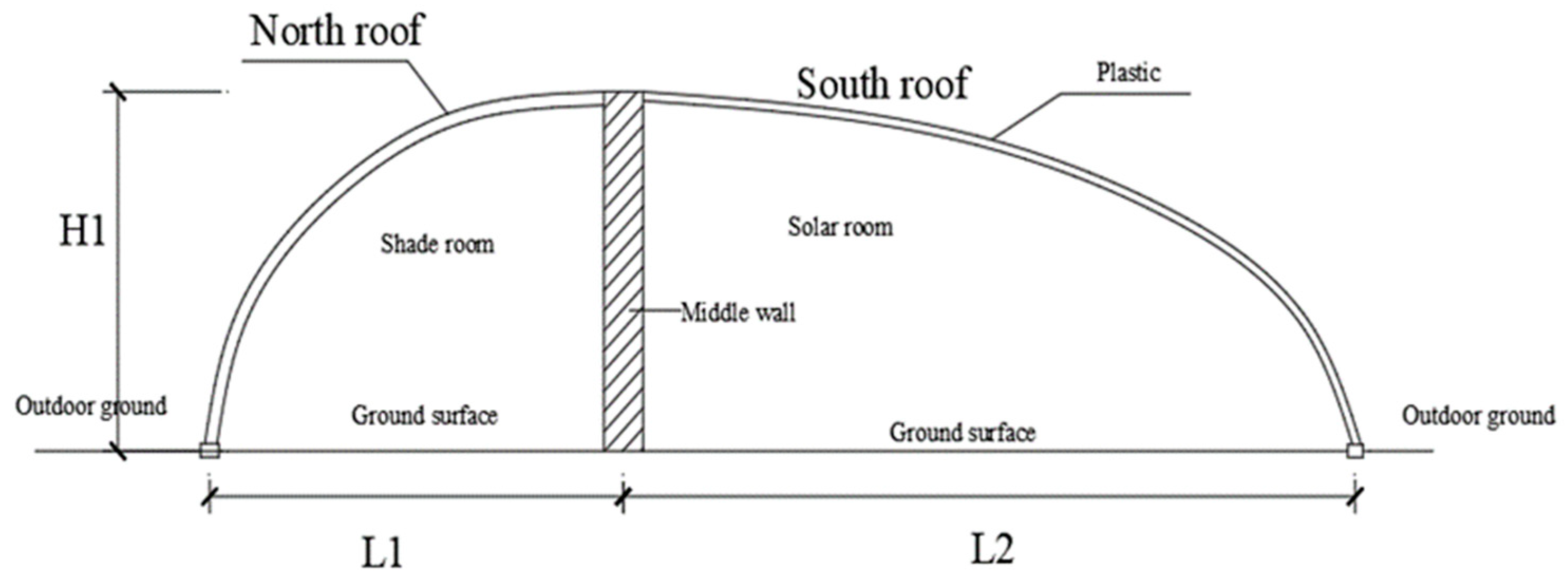

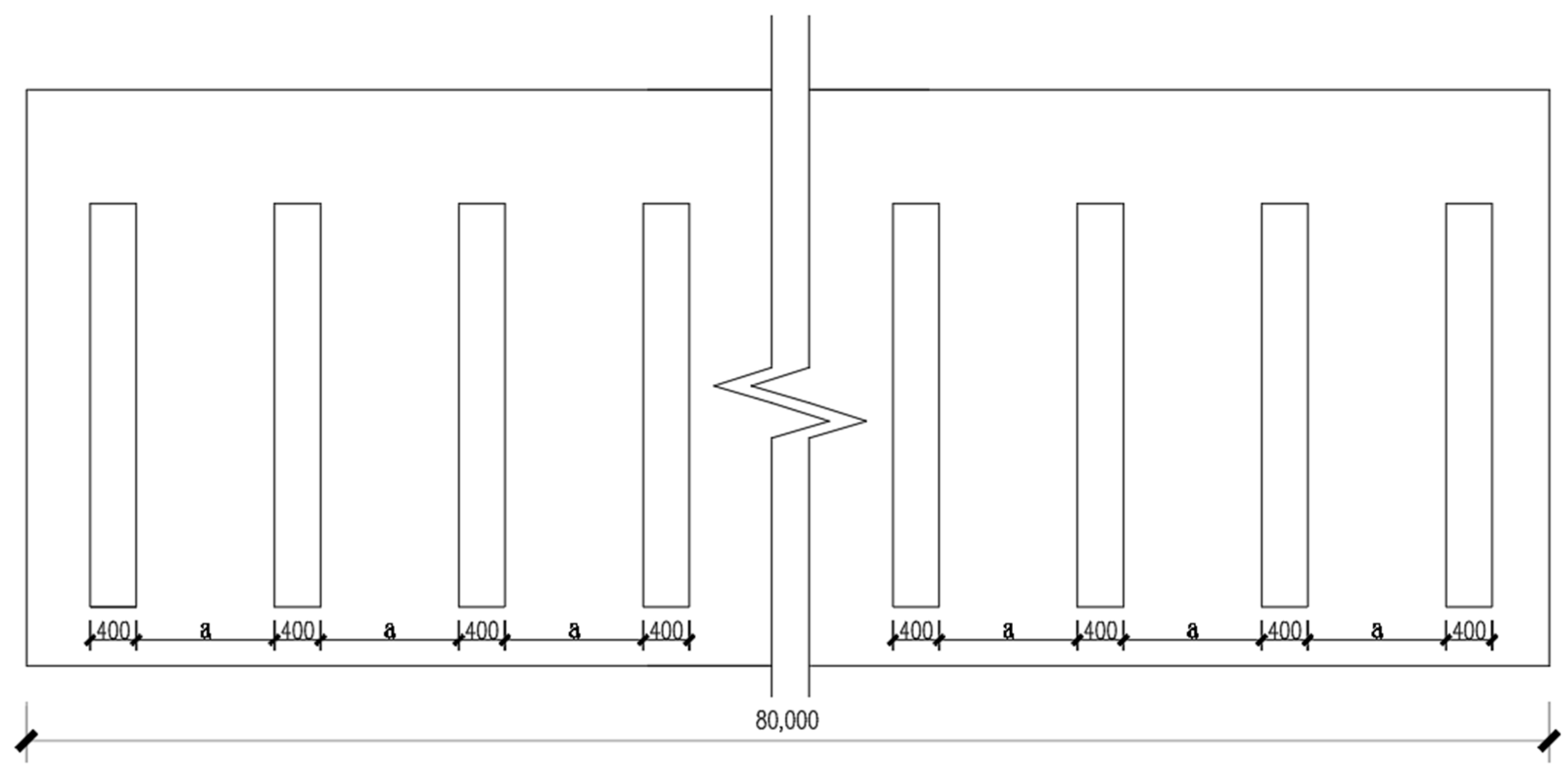




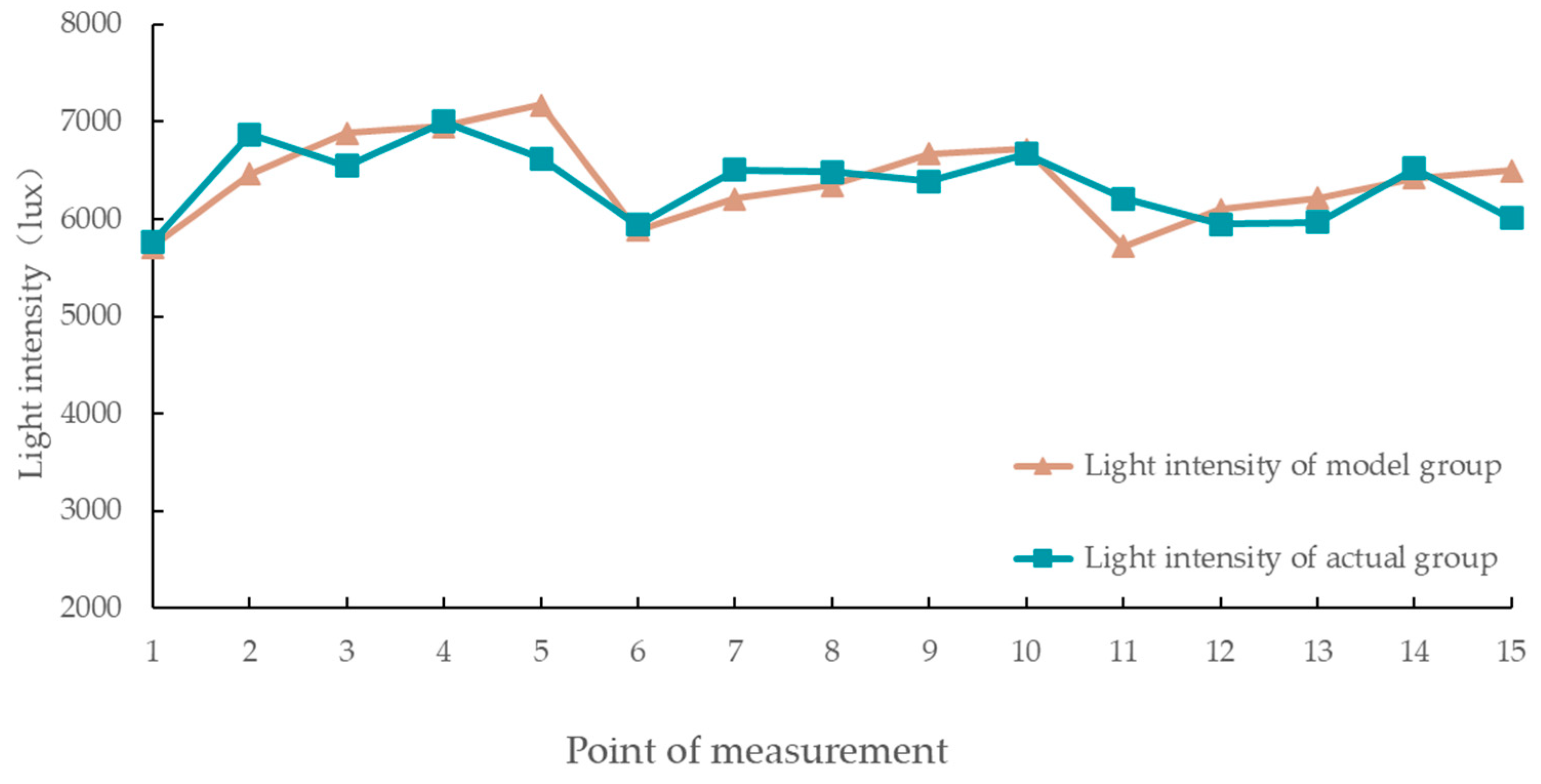
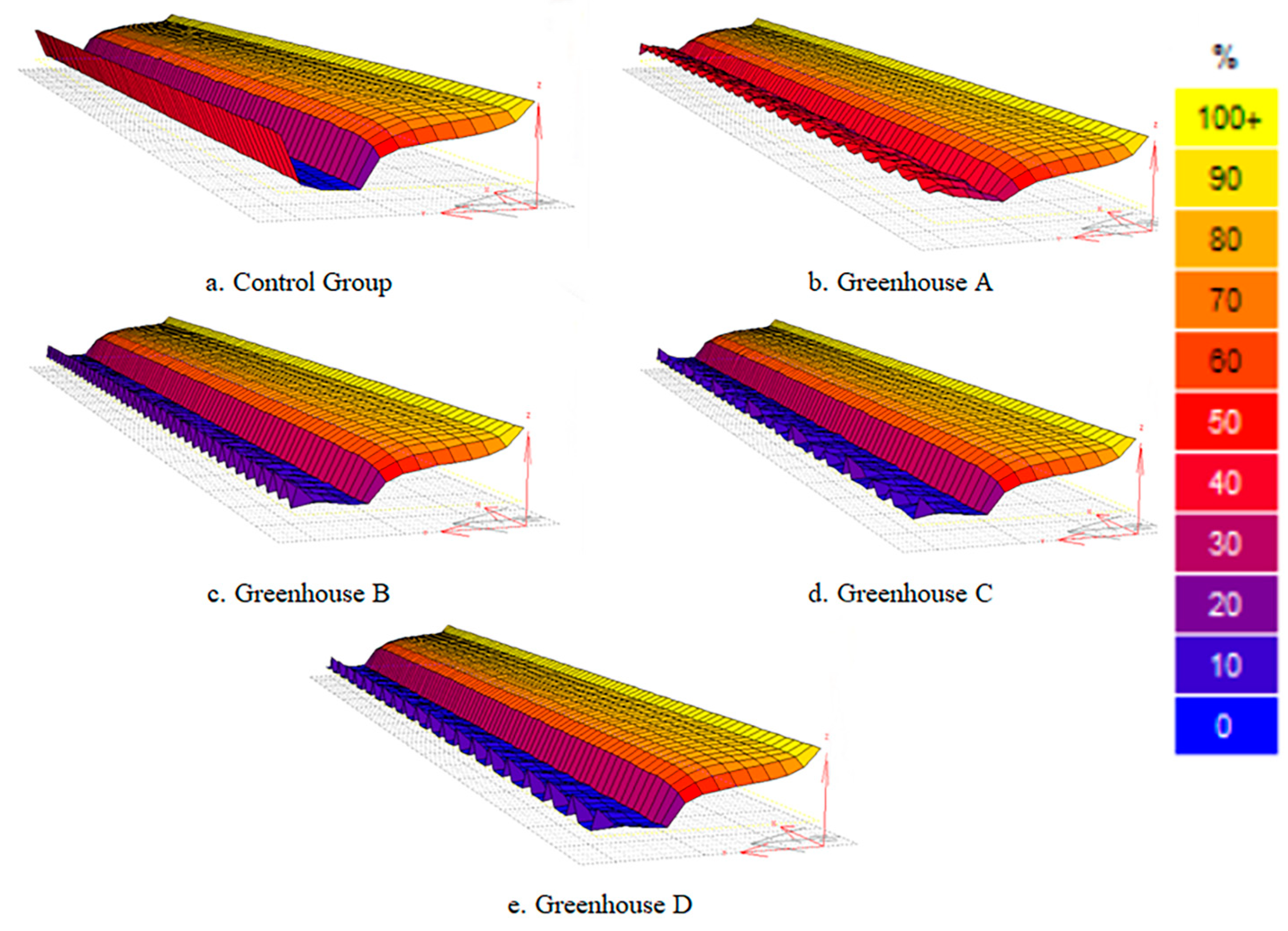
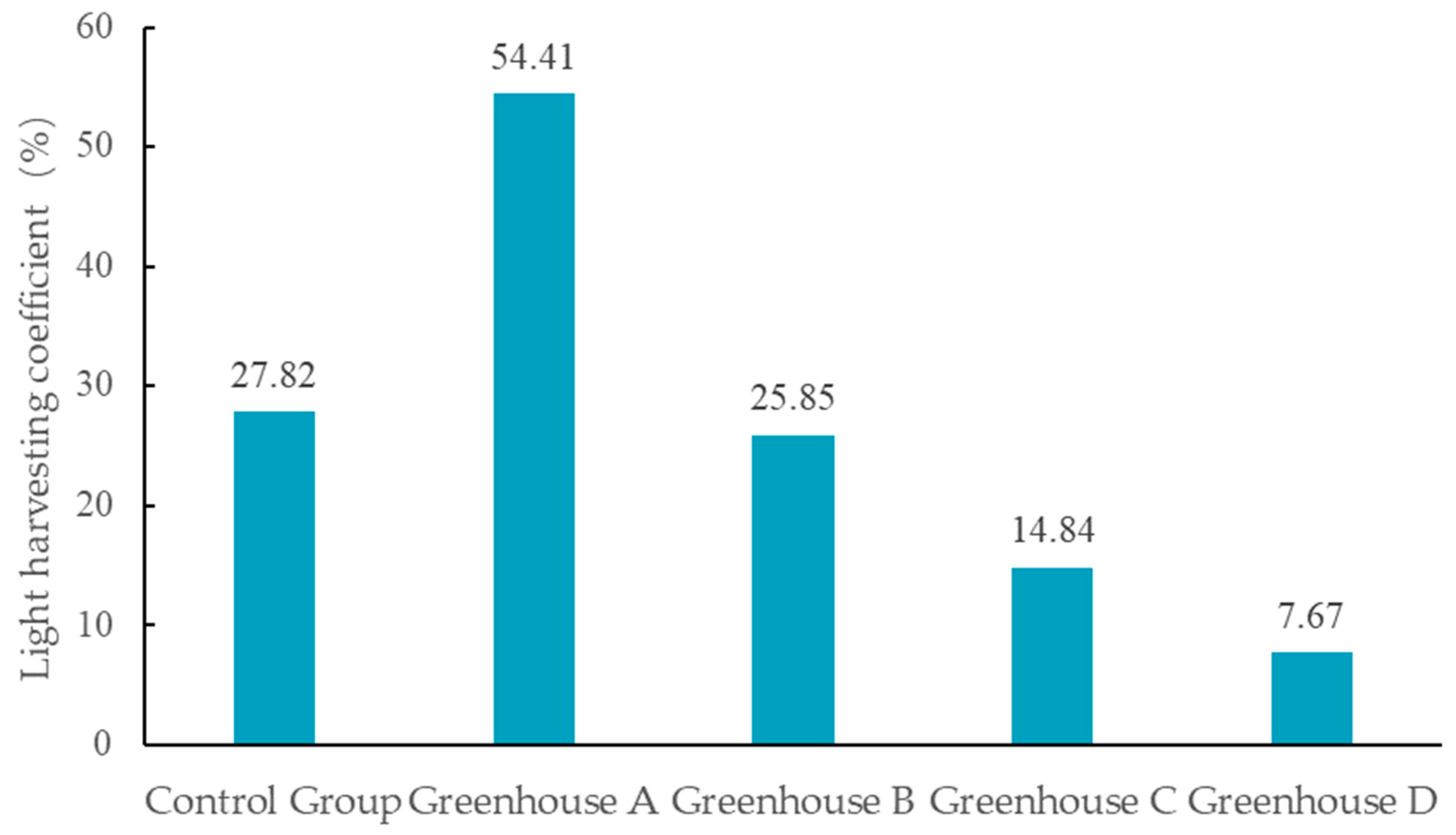
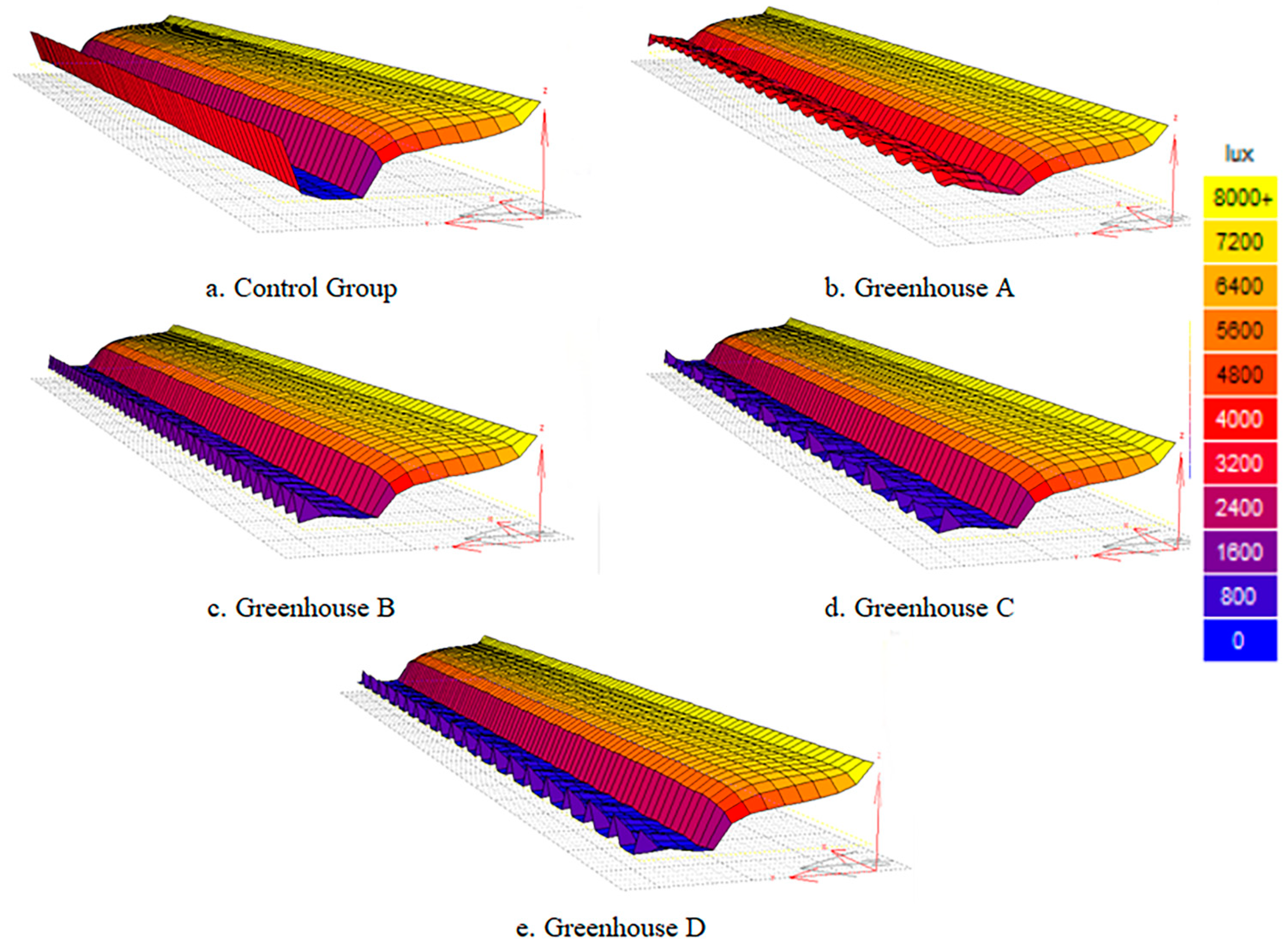


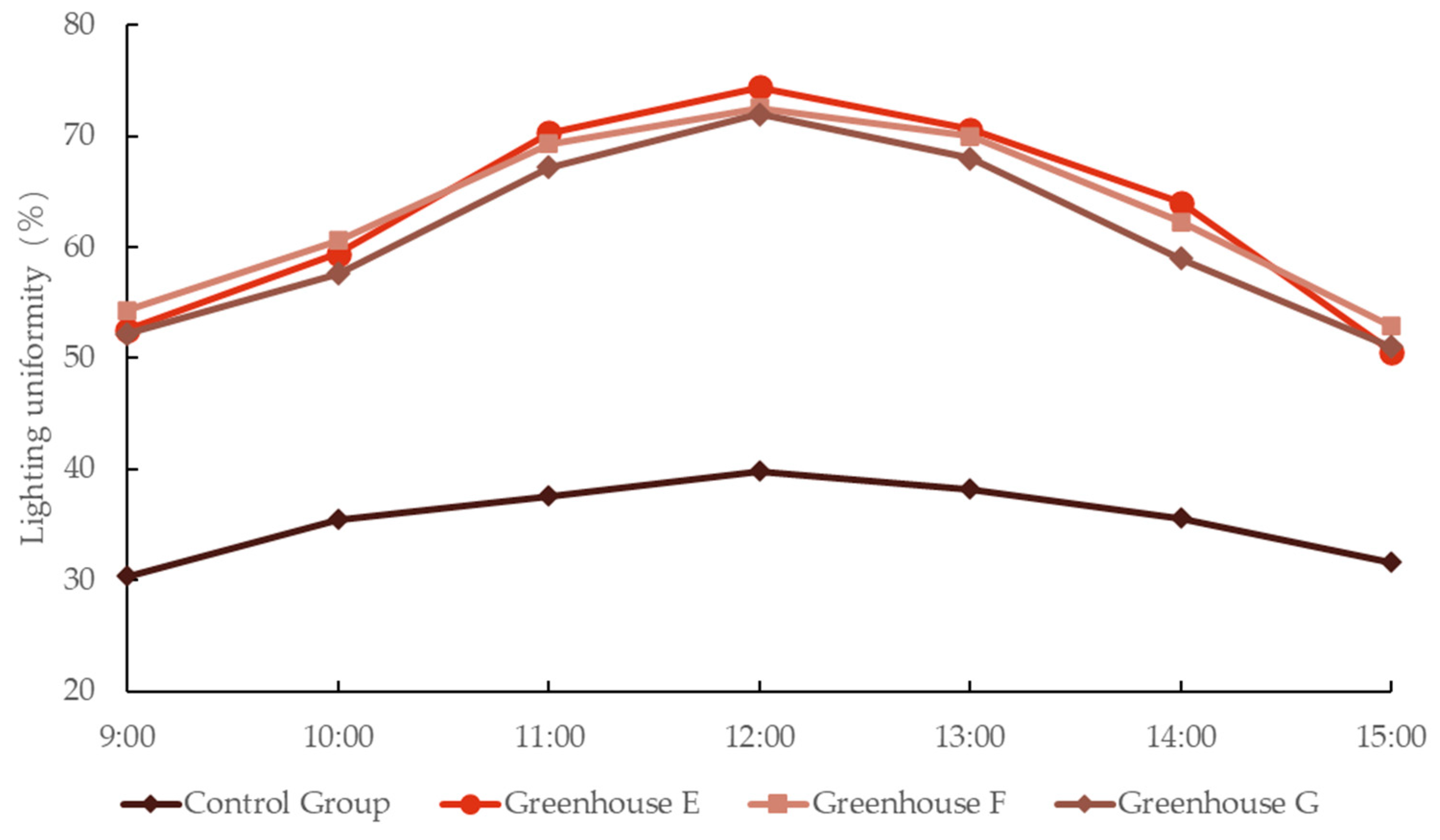
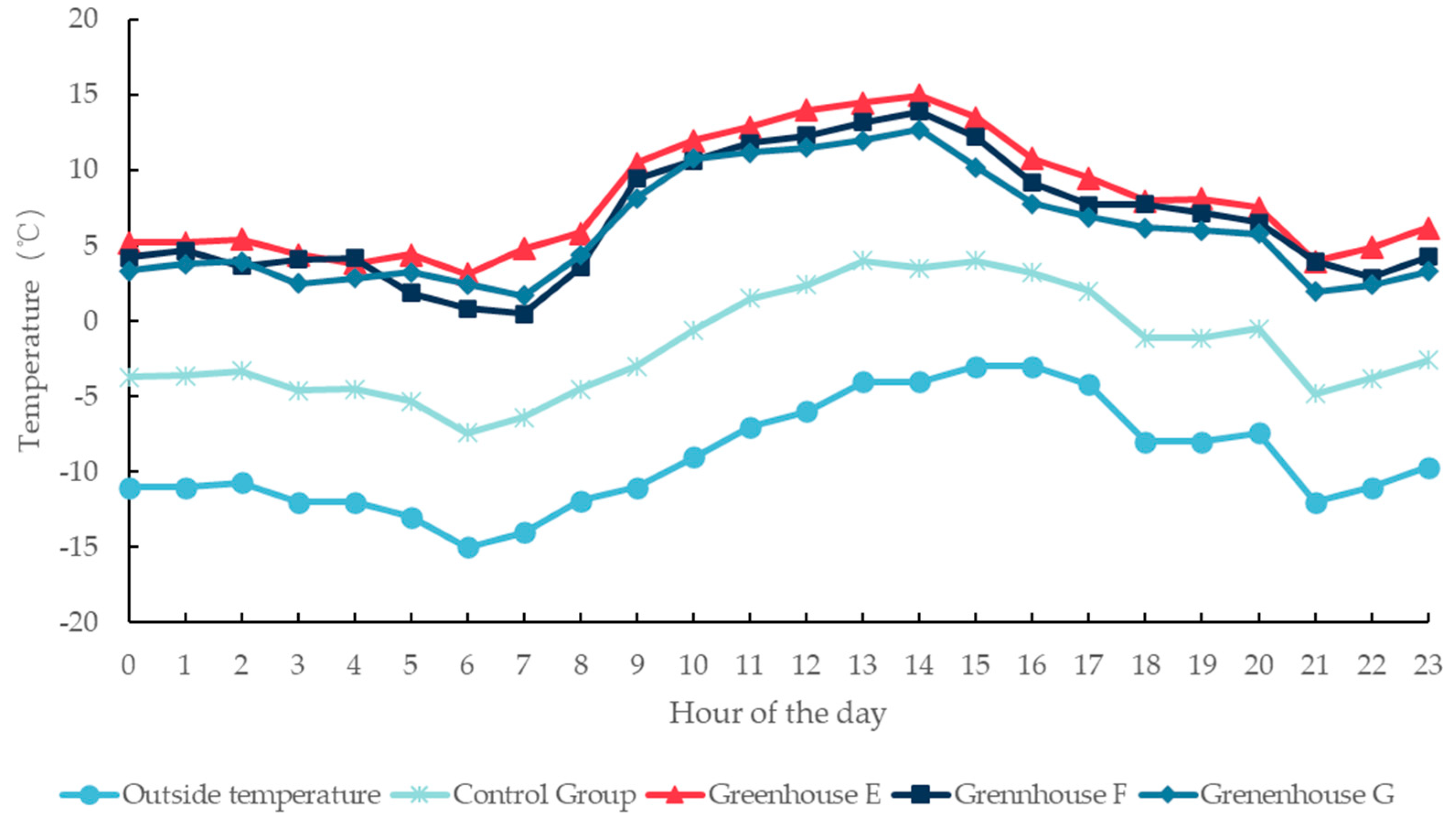
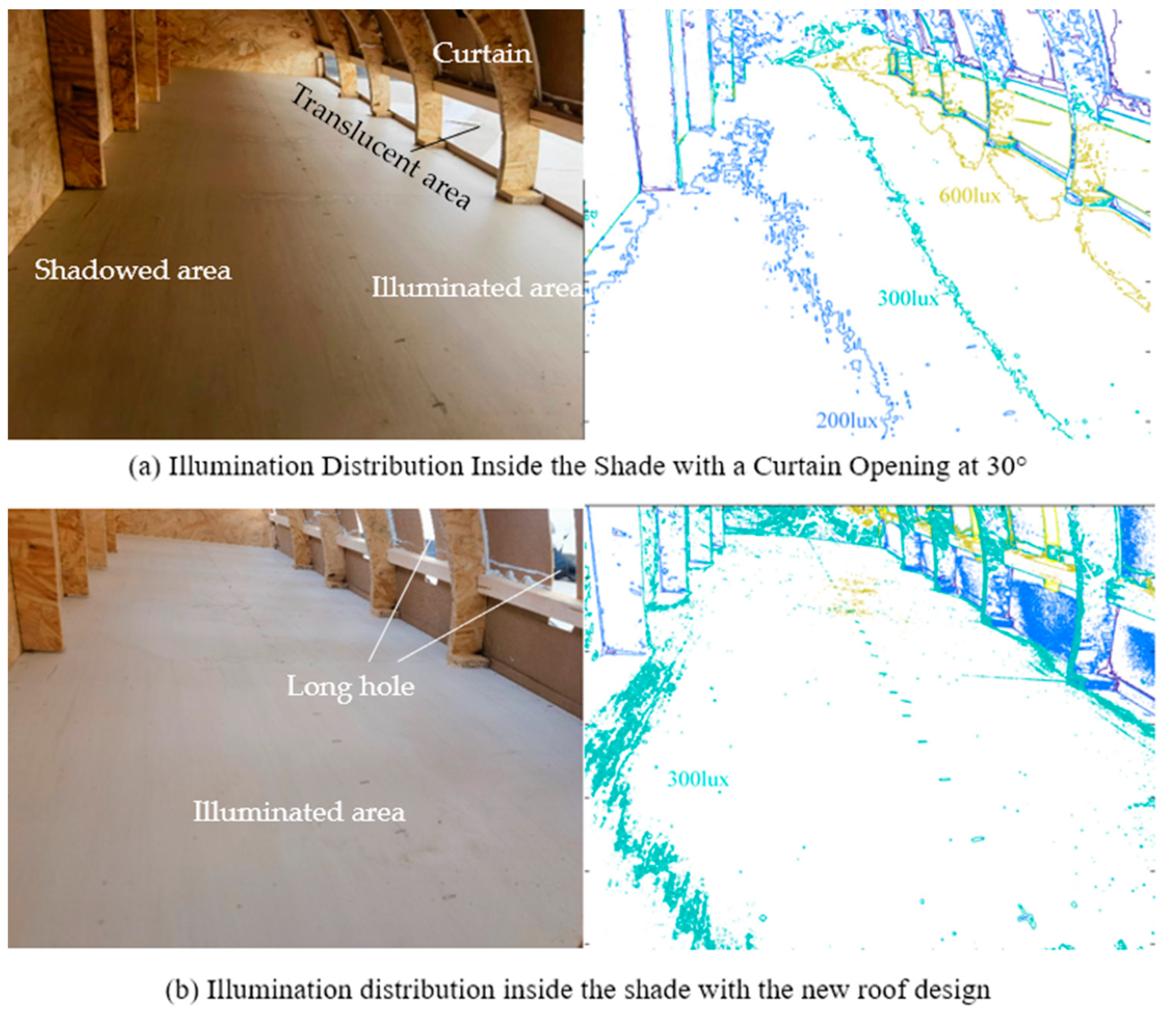
| Material | Density/kg·m−3 | Specific Heat Capacity /J·(kg·K)−1 | Heat Storage Coefficient /W·(m2·K)−1 | Thermal Conductivity /W·(m·K)−1 | Absorption Rate |
|---|---|---|---|---|---|
| Slag brick | 1700 | 1050 | 12.72 | 0.87 | 0.50 |
| EVA film | 950 | 2010 | - | 0.04 | - |
| Polyurethane | 35 | 1380 | 0.54 | 0.02 | - |
| FRP board | 1500 | 1260 | 9.26 | 0.40 | - |
| Planting soil | 1600 | 1010 | 9.45 | 0.76 | 0.80 |
| Air Gap | 1.3 | 1004 | - | 0.03 | - |
| Glass Standard | 2300 | 836 | - | 1.05 | 0.12 |
| Component | Parameter | Greenhouse |
|---|---|---|
| Greenhouse characteristics | Azimuth angle | South 180° |
| Length/m | 80 | |
| Height (H1)/m | 4.0 | |
| Width of shade room (L1)/m | 5.0 | |
| Width of solar room (L2)/m | 9.0 | |
| Middle wall | Height/m | 4.0 |
| Total thickness/m | 0.24 | |
| Material and construction | Slag bricks cemented with cement mortar | |
| East and west wall | Height/m | Shown in Figure 1 |
| Total thickness/m | 0.56 | |
| Material and construction | Slag brick wall at the outermost layer; the thickness is 0.12 m. | |
| Polystyrene board in the middle layer; the thickness is 0.07 m. | ||
| Slag brick wall at the innermost layer; the thickness is 0.37 m. | ||
| North roof (Control group) | Material and construction | The lower 1/3 of the shade roof is used for light and the rest is covered with insulation. |
| The inner layer is EVA plastic; the thickness is 0.0001 m. | ||
| North roof (Experimental group) | Material and construction | FRP board at the innermost layer; the thickness is 0.0008 m. Rigid foamed polyurethane in the middle layer; the thickness is 0.12 m. Smearing the surface with 1:2.5 cement mortar plus crack resistant fiber; the thickness is 0.02 m. The windows are aluminum-framed double-glazed windows with a glass thickness of 0.006 m and an intermediate air layer thickness of 0.004 m. |
| South roof | Material and construction | EVA plastic at the innermost layer; the thickness is 0.0001 m. |
| Ground | Ground cover | Shade room ground covered by bricks |
| Solar room ground covered by planting soil | ||
| Location | Latitude | 36.69° N |
| Longitude | 121.18° E | |
| Simulating dates | The winter day | 31 December |
| Components | Control Group | Greenhouse A | Greenhouse B | Greenhouse C | Greenhouse D |
|---|---|---|---|---|---|
| Window spacing(a)/mm | - | 1000 | 2000 | 3000 | 4000 |
| Curtain Opening | Average Illumination Intensity/(lux) | Illumination Distribution Uniformity/(%) |
|---|---|---|
| 0° | - | - |
| 30° | 395 | 53 |
| 60° | 582 | 78 |
| 90° | 686 | 93 |
| Designed new roof | 325 | 92 |
Disclaimer/Publisher’s Note: The statements, opinions and data contained in all publications are solely those of the individual author(s) and contributor(s) and not of MDPI and/or the editor(s). MDPI and/or the editor(s) disclaim responsibility for any injury to people or property resulting from any ideas, methods, instructions or products referred to in the content. |
© 2024 by the authors. Licensee MDPI, Basel, Switzerland. This article is an open access article distributed under the terms and conditions of the Creative Commons Attribution (CC BY) license (https://creativecommons.org/licenses/by/4.0/).
Share and Cite
Yang, X.; Ma, Y. Design and Thermal-Optical Environment Simulation of Double-Slope Greenhouse Roof Structure Based on Ecotect. Agriculture 2024, 14, 1410. https://doi.org/10.3390/agriculture14081410
Yang X, Ma Y. Design and Thermal-Optical Environment Simulation of Double-Slope Greenhouse Roof Structure Based on Ecotect. Agriculture. 2024; 14(8):1410. https://doi.org/10.3390/agriculture14081410
Chicago/Turabian StyleYang, Xuanhe, and Yunfei Ma. 2024. "Design and Thermal-Optical Environment Simulation of Double-Slope Greenhouse Roof Structure Based on Ecotect" Agriculture 14, no. 8: 1410. https://doi.org/10.3390/agriculture14081410




